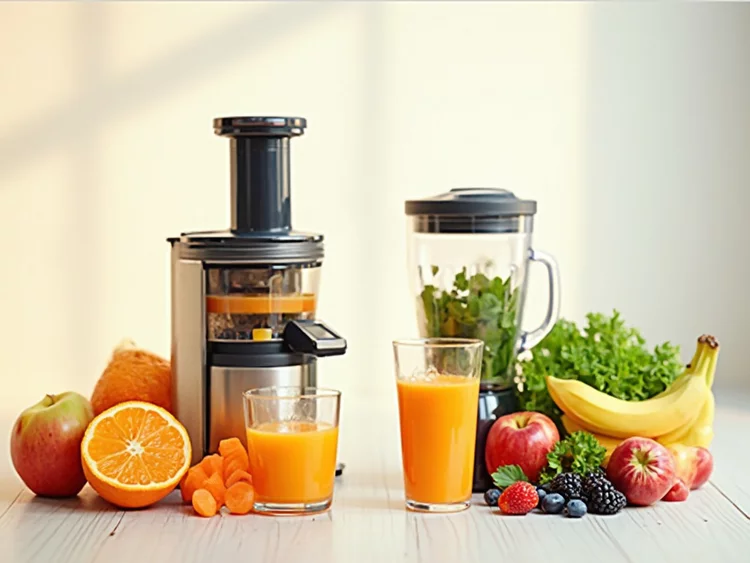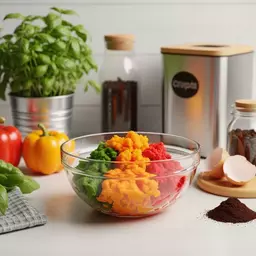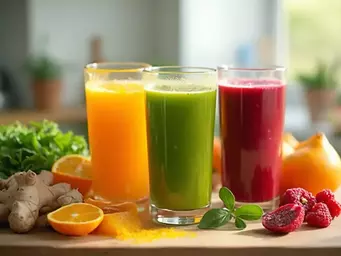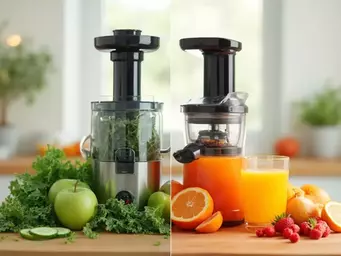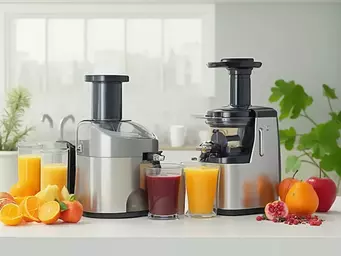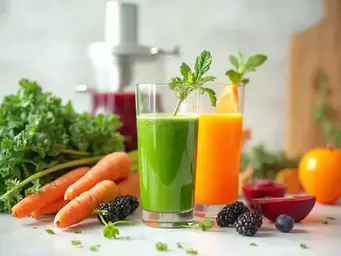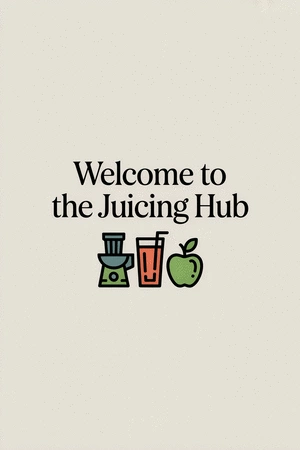Have you ever stood in your kitchen, staring at a pile of vibrant fruits and vegetables, wondering how to capture their essence in a glass? Juicing is not just a health trend; it’s a delightful way to infuse your daily routine with nature’s goodness. Let’s explore the simple joys of juicing together!
What You Will Learn
- Juicing provides a concentrated dose of vitamins and minerals, while blending retains fiber for sustained energy.
- Blending supports digestive health with fiber, whereas juicing may lead to quicker nutrient absorption.
- Smoothies may keep you fuller for longer due to their fiber and healthy fat content, unlike juices that offer more immediate energy.
- Juice cleanses can increase energy, promote weight loss, and improve digestion, but should be approached cautiously.
- Choosing the right equipment can enhance your juicing and blending experience significantly.
Juicing vs. Blending: A Comparative Overview
Delve into the key differences and benefits of juicing and blending to decide which method best suits your nutritional goals and lifestyle needs.
Juicing: Quick Nutrient Absorption
- ✓ Concentrated vitamins & minerals
- ✓ Easy digestion & quick energy
- ✓ Ideal for nutrient boosts
- ✗ Removes fiber (less satiety)
- ✗ Can spike blood sugar
Best for: Detox, rapid nutrient intake, digestive rest.
Blending: Sustained Energy & Fiber
- ✓ Retains all fiber & pulp
- ✓ Promotes digestive health
- ✓ Higher satiety, controls appetite
- ✗ Thicker consistency
- ✗ Slower nutrient release
Best for: Weight management, digestive support, meal replacement.
Understanding Juicing and Blending: A Nutritional Overview
Have you ever wondered what makes juicing and blending such popular choices in the wellness world? Both methods offer unique benefits that can enhance your health and well-being. At The Juicing Hub, we dive into the essentials of juicing and blending to help you understand which is best for your lifestyle!
What is Juicing and How Does It Work?
Juicing is the process of extracting liquids from fruits and vegetables, leaving behind the pulp and fiber. This method allows for a concentrated dose of vitamins, minerals, and antioxidants. Simple, right? But there’s a bit more to it! Let’s explore the different methods and tools involved.
The Process of Juicing: Methods and Tools
There are several ways to juice, each with its own tools and techniques:
- Centrifugal Juicers: These machines spin at high speeds to extract juice quickly. They’re great for beginners due to their efficiency!
- Masticating Juicers: Also known as cold press juicers, these extract juice slowly, preserving more nutrients and enzymes.
- Hand Juicers: Perfect for small batches, these are simple and cost-effective. All you need is some elbow grease!
Regardless of the method you choose, the result is a refreshing glass of juice packed with nature’s goodness.
Nutrient Extraction: What You Gain from Juicing
One of the biggest advantages of juicing is the ability to consume a variety of nutrients in one serving. You'll gain:
- Vitamins: Juices are rich in essential vitamins like C and A, which support your immune system and skin health.
- Antioxidants: These protect your cells from damage and can reduce the risk of chronic diseases.
- Hydration: Juicing often includes high-water content fruits and veggies, keeping you hydrated!
These nutrients work together to provide an energy boost and promote overall wellness. For a deeper understanding of how juicing compares to whole foods, consider this perspective on how juice compares to whole food consumption.
Juice Cleanse: Benefits and Considerations
Juice cleanses are popular for those looking to detox and reset their bodies. During a cleanse, you consume only juice for a set period, allowing your digestive system to rest. Potential benefits include:
- Increased Energy: Many people report feeling more energized after a cleanse!
- Weight Loss: It can kickstart weight loss due to reduced calorie intake.
- Improved Digestion: A break from solid foods can help reset your digestive system.
However, it’s essential to approach juice cleanses carefully. Consulting a healthcare professional is always a good idea to ensure it aligns with your health goals. For more insights into the potential benefits and risks, you can explore information from the National Institutes of Health regarding dietary interventions like juice cleanses.
Blending: How It Differs from Juicing
Blending, on the other hand, retains all the fiber from fruits and vegetables, resulting in a thicker consistency. This can be a delicious and satisfying way to fuel your body! Let’s take a closer look at the blending process.
The Blending Process: Ingredients and Techniques
To create a smoothie, you generally combine whole fruits, vegetables, and liquids like water or plant-based milk in a blender. Here are key ingredients you might consider:
- Fruits: Bananas, berries, and apples add natural sweetness.
- Vegetables: Spinach and kale boost nutrient content without overpowering the flavor.
- Healthy Fats: Avocado or nut butter provide creaminess and satiety.
By blending these ingredients together, you create a nutrient-rich drink that keeps you full for longer!
Fiber Retention and Its Nutritional Value
One significant difference between juicing and blending is fiber retention. Blending preserves the fiber from whole fruits and vegetables, which can be beneficial for digestive health. Fiber has many advantages:
- Promotes Digestive Health: It aids in regularity and helps prevent constipation.
- Helps Control Appetite: Fiber keeps you feeling full, making it easier to manage portion sizes.
- Stabilizes Blood Sugar Levels: It slows the absorption of sugar into the bloodstream.
With all these benefits, blending can be a fantastic addition to your daily routine! You can find a comprehensive comparison of juicing and blending, including their effects on fiber, on NutritionEd.org.
Green Smoothies: A Nutrient-Packed Choice
Green smoothies are particularly popular for their high nutrient content. By combining leafy greens with fruits, you can enjoy a refreshing, health-boosting drink! Here’s how to make a great green smoothie:
- Choose Your Greens: Spinach or kale work well.
- Add Fruits: Bananas or mangoes add sweetness.
- Include a Liquid Base: Water, coconut water, or almond milk can enhance consistency.
The resulting drink is a flavorful way to pack in nutrients without feeling deprived!
Pro Tip
To maximize the nutritional benefits of your juices and smoothies, consider adding a tablespoon of chia seeds or flaxseeds. These superfoods not only boost fiber content but also provide essential omega-3 fatty acids, enhancing heart health and promoting satiety!
Frequently Asked Questions About Juicing and Blending
Q: What is the main difference between juicing and blending?
A: Juicing extracts liquid from fruits and vegetables, removing the fiber and pulp, leading to quicker nutrient absorption. Blending, however, retains all the fiber, resulting in a thicker consistency and slower nutrient release, which promotes satiety and digestive health.
Q: Which method is better for weight loss?
A: Blending is often considered better for weight loss because it retains fiber, which helps you feel fuller for longer and can aid in appetite control. While juice cleanses can kickstart weight loss, they should be approached cautiously and ideally with professional guidance.
Q: Can juicing spike blood sugar levels?
A: Yes, because juicing removes fiber, which helps regulate sugar absorption, consuming juice can sometimes lead to a quicker spike in blood sugar compared to smoothies or whole fruits.
Q: What are the benefits of a juice cleanse?
A: Juice cleanses are believed to increase energy, promote initial weight loss, and improve digestion by giving the digestive system a temporary rest. However, it's crucial to consult a healthcare professional before starting one.
Q: What equipment do I need to start juicing or blending?
A: For juicing, you'll need a quality juicer (centrifugal or masticating) and storage containers. For blending, a high-powered blender is essential. Look for equipment that is easy to clean, durable, and versatile.
Summing Up the Nutritional and Digestive Benefits
As we wrap up our discussion on juicing and blending, it's essential to highlight the key takeaways that can help you make informed decisions for your health. Understanding the differences between these two methods can significantly impact your nutritional intake and overall wellness journey!
Whether you prefer the quick absorption of nutrients through juicing or the sustained energy from blending, recognizing what fits your lifestyle is crucial. Each method offers unique benefits that cater to different health goals, and it's all about what works best for you.
Key Takeaways: Juicing vs. Blending
Let's break down the essentials of juicing and blending to find the approach that suits your needs:
- Nutrient Density: Juicing provides a concentrated dose of vitamins and minerals, while blending retains fiber for sustained energy.
- Digestive Benefits: Blending supports digestive health with fiber, whereas juicing may lead to quicker nutrient absorption.
- Satiety Levels: Smoothies may keep you fuller for longer due to their fiber and healthy fat content, unlike juices that offer more immediate energy.
Understanding these factors can help you tailor your juicing and blending practices to fit your personal health goals. Are you aiming for quick energy, or do you want lasting fullness? These insights can guide your choices!
Understanding the Right Approach for Your Lifestyle
Adapting your juicing or blending routine to your lifestyle is key! For instance, if you lead a busy life, juicing might be your go-to for a quick nutrient boost. On the other hand, if you're focused on weight management, blending could provide the satisfying meals you need.
Remember, it's all about finding what resonates with you. Consider experimenting with both methods and see how your body responds. Do you feel more energized with a fresh juice, or do you find smoothies keep you fuller longer?
Making Informed Choices Based on Nutritional Needs
When it comes to making informed choices, keep your personal health goals in mind. If you're looking to increase your vitamin intake, juicing can be a fantastic option. However, if you want to boost your fiber consumption, blending is the way to go.
It's also wise to consult with a healthcare professional if you have specific nutritional needs or dietary restrictions. They can provide personalized advice, ensuring your juice and smoothie choices are beneficial!
Health Myths: Debunking Common Misconceptions
As we explore the world of juicing and blending, several myths often arise. One common misconception is that juices lack nutritional value. In reality, fresh juices can be packed with vitamins, minerals, and antioxidants!
Another myth is that smoothies are always healthier. While they are nutrient-dense, the ingredients you choose greatly influence their health benefits. Always aim for wholesome ingredients to maximize nutrition!
Engaging with the Right Products for Your Journey
Now that you have a better understanding of juicing and blending, let’s talk about choosing the right products for your kitchen. The right tools can make a significant difference in your juicing and blending experience!
Investing in quality equipment not only improves the efficiency of your process but also enhances the overall taste and nutrition of your creations.
Exploring Blenders and Juicers: What to Look For
When selecting a juicer or blender, consider the following:
- Ease of Cleaning: Look for models that are easy to disassemble and clean.
- Durability: Choose brands known for quality and longevity.
- Versatility: Some blenders and juicers can handle a variety of tasks, from soups to frozen desserts!
These features can elevate your juicing and blending game, making it enjoyable and efficient!
Tips for Creating Delicious and Nutritious Blends and Juices
If you're looking to enhance your creations, here are some tips:
- Mix different fruits and veggies for unique flavors.
- Use fresh, organic produce whenever possible to maximize nutrition.
- Experiment with herbs and spices to boost taste and health benefits.
By applying these tips, you can create smoothies and juices that are not only delicious but also packed with nutrition!
Juicing Equipment: Essential Tools for Success
To set yourself up for success in your juicing journey, having the right equipment is essential. Here’s a quick list of must-have tools:
- Quality Juicer: A good juicer extracts the most nutrients from your fruits and vegetables.
- High-Powered Blender: This is key for achieving smooth textures in your smoothies.
- Storage Containers: Airtight containers help keep your juices fresh for longer.
With these tools at your disposal, you’ll be well on your way to enjoying the many benefits of juicing and blending!
Getting Started with Juicing and Blending
Are you ready to take your health into your own hands? Let’s get started on incorporating juicing and blending into your daily routine!
Recap of Key Points
Here is a quick recap of the important points discussed in the article:
- Nutrient Density: Juicing offers a concentrated dose of vitamins and minerals, while blending retains fiber for sustained energy.
- Digestive Benefits: Blending supports digestive health through fiber, whereas juicing may lead to quicker nutrient absorption.
- Satiety Levels: Smoothies can keep you fuller for longer due to their fiber and healthy fat content, unlike juices which provide immediate energy.
- Choosing the Right Method: Assess your lifestyle to determine whether juicing or blending aligns better with your health goals.
- Informed Choices: Consult with a healthcare professional to ensure your juicing or blending practices meet your nutritional needs.
- Quality Equipment: Investing in good juicers and blenders can enhance your experience and the quality of your juices and smoothies.
